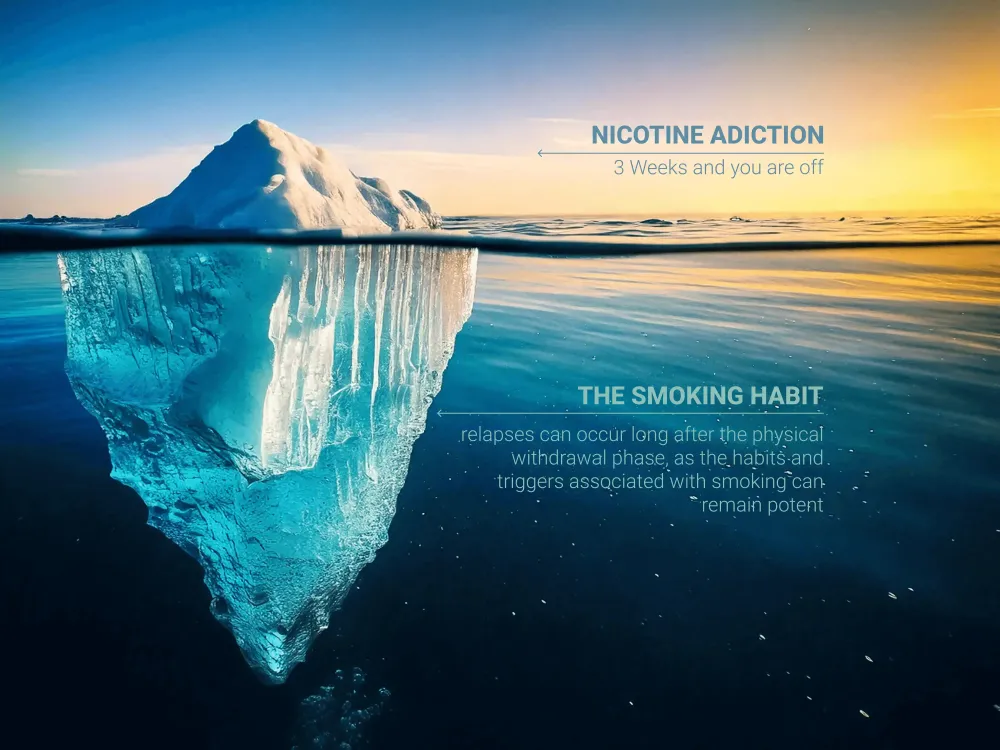4 Biggest Reasons People Struggle to Quit Smoking
Plus, Proven Solutions to Quit Smoking for Good
Daniel Stefan
Oct 15, 2024
8 min read

Did you know that, without support, only 2-3% of smokers manage to quit permanently?
Quitting smoking can feel like one of the hardest things you’ll ever do, and for good reason. Beyond nicotine cravings, smokers face a complex mix of physical, emotional, and social challenges when they decide to quit. If you’re trying to kick the habit but feel like you’re fighting an uphill battle, you’re not alone. Many people struggle with the same obstacles that make quitting feel nearly impossible.
In this article, we’ll explore the top four reasons people find it hard to quit smoking, an—most importantly—share actionable solutions to overcome each one. By understanding these common pitfalls and tackling them with proven strategies, you can set yourself up for success and take real steps toward a smoke-free life.
Problem: Many people believe that if you truly want to quit smoking, sheer willpower will do the trick. I remember my father often saying, “If you really want it, just stop!” But what he didn’t realize is that this belief isn’t backed by science.
Research from the National Institute on Drug Abuse (NIDA) shows that the reality is grim: Only about 2-3% of smokers manage to quit permanently without assistance from cessation programs or medications.

Moreover, studies like The Role of Self-Change in Smoking Cessation(1) found that individuals attempting to quit without any support had a long-term cessation rate of around 2-5%, indicating that willpower alone is generally ineffective.
Think about it this way: If you knew there was a 97% chance of being struck by lightning, would you walk outside? Probably not! Relying solely on willpower to quit smoking is just as risky.
In contrast to going solo in the fight, structured smoking cessation programs have shown much higher success rates. For example, studies such as Long-term effects of a structured smoking cessation program(2) reported that participants in these programs had a quit rate of about 30% at 6 months and maintained a 20% abstinence rate at 12 months.
Solution: Instead of going barehanded, consider a well-structured smoking cessation program. It’s like having a detailed map on a complex journey. This significantly increases your chances of quitting—potentially by as much as four times (20% cessation rate compared to 5%).
Problem: Many people view a relapse as a permanent failure rather than a normal part of the quitting process. This mindset often leads smokers to give up altogether, akin to stopping just three feet from the gold.
The American Cancer Society estimates that only about 4-7% of smokers who attempt to quit will be successful long-term on their first try. This statistic emphasizes that most successful quitters make multiple attempts before achieving lasting cessation.
Numerous studies, including longitudinal research, demonstrate that quitting smoking is like going the extra three feet for the gold. One, titled Assessing the Effectiveness of Smoking Cessation Interventions(3), found that those who kept trying through multiple attempts had a success rate of about 20-25%. In contrast, first-time quitters? They’re looking at a mere 3-5%.

Fail nine times, get back up ten times, and you’re still in the running for the gold medal.
Solution: Understanding that quitting is a marathon, not a sprint, can increase your chances of quitting by as much as 5 times (25% cessation rate compared to 5%).
Problem: Another common misconception is that overcoming nicotine addiction is equivalent to stopping smoking altogether, but that’s like putting a band-aid on a broken leg.
Scientifically speaking, nicotine is usually cleared from the bloodstream within 1 to 3 days. While nicotine can be detected in urine for up to 3-4 days, its primary metabolite, cotinine, may remain detectable for about 1 to 3 weeks. Once nicotine is fully cleared from your system—typically after 1 to 2 weeks—withdrawal symptoms related to the chemical addiction generally subside.

Think of it like this: the Titanic wasn’t sunk by the part of the iceberg it could see, but by the massive, hidden part lurking below. Similarly, studies like Nicotine Dependence and Withdrawal in Smoking Cessation(4) show that the real threat to quitting isn’t just nicotine—it’s the deeply embedded routines, triggers, and emotional associations with smoking. These hidden aspects can pull smokers back long after nicotine leaves the body, presenting the biggest obstacles to staying smoke-free.
According to the The Effectiveness of Behavioral Interventions for Smoking Cessation(6) study, behavioral interventions alone can achieve cessation rates ranging from 10% to 20% after 6 months, depending on the type and intensity of the intervention.
Solution: Addressing the habitual factors is crucial for achieving long-term success in quitting smoking and can increase four times your chances of quitting (20% cessation rate compared to 5% will-power only rate).
Problem: Another misconception about quitting smoking is that it can be accomplished entirely alone, often stemming from fear of being judged by others.

One study, Self-Initiated Smoking Cessation: The Role of Social Support and Self-Efficacy(7), highlights that individuals who attempt to quit without any support have a long-term cessation rate of only about 2-5%. In contrast, those who engage with support systems—whether through counseling, support groups, or social networks—see success rates soar to 10-25%. This means that support can increase your chances of quitting by up to five times (from 5% to 25%).
When considering well-known support groups, Alcoholics Anonymous (AA) is perhaps the most recognized. While Nicotine Anonymous specifically targets smoking cessation, AA offers valuable insights into the role of support in recovery. The study Rates of Improvement in Alcoholics Anonymous and Other Treatment Programs(8) found that a remarkable 50% of participants who engaged in AA for a year achieved sobriety.
What makes AA as effective, if not more so, than other interventions—like a Tomahawk missile hitting its target—are several key factors:
- A Sponsor: Members are paired with a sponsor who provides personal support, guidance, and accountability throughout their recovery journey.
- Community Support: AA fosters a sense of belonging by connecting individuals facing similar struggles. This community aspect reinforces commitment and encourages shared experiences.
- Spiritual Foundation: AA heavily emphasizes the role of a higher power, encouraging members to seek help from God, which can be a source of strength and motivation.
Solution: Acknowledging that smoking addiction can overwhelm us and relying on a support network significantly increases your chances of quitting—up to five times (from 5% to 25%). The quality of the support network directly correlates with better outcomes, as evidenced by the 50% success rate in AA.
So, lace up those sneakers—you're about to start your journey toward a healthier you! While specific rates may vary by study, the following general trends and principles are well-documented in the literature on smoking cessation:
1. Engage in a Well-Structured Smoking Cessation Program: Increase your chances of success from just 5% to 20% by taking advantage of structured programs proven to help people quit.
2. Persist Through Multiple Attempts: Keep going! Persistence can raise your odds of quitting to 25% compared to the 5% rate for those who stop trying after one attempt. Remember: every attempt brings you closer.
3. Address Habitual Factors: Breaking habits is essential. Those who tackle the behavioral side of smoking have 20% quit rates compared to just 5% for those who don’t focus on habits.
4. Lean on a Reliable Support Network: Don’t go it alone. A strong support network can multiply your chances of quitting by five, raising success rates to 25% compared to 5% for those without support.
Quitting smoking is a journey, but with the right tools, it’s absolutely achievable. If you’re ready to take the first step, consider a structured program—one that combines proven principles and offers guidance every step of the way.
For years, I tried everything: pills, popular methods, routines—all in hopes of finally quitting. In 2013, it struck me: what if I could combine the most effective science-backed principles like the above into one comprehensive program? The result was the BravoBee program, where quitting didn’t just feel possible—it felt surprisingly easy.

Studies:
(1) The Role of Self-Change in Smoking Cessation Findings: Individuals who attempted to quit without support had a long-term cessation rate of around 2-5%, indicating that willpower alone is generally ineffective. Reference: Sullivan, M. A., & Fiore, M. C. (2010). Addiction, 105(9), 1601-1605. DOI: 10.1111/j.1360-0443.2010.02963.x
(2) Long-term Effects of a Structured Smoking Cessation Program Findings: Participants in structured programs have a quit rate of about 30% at 6 months, maintaining a 20% abstinence rate at 12 months; control group rates were approximately 5%. Reference: Fiore, M. C., et al. (2008). The American Journal of Public Health, 98(8), 1497-1503. DOI: 10.2105/AJPH.2007.120865
(3) Assessing the Effectiveness of Smoking Cessation Interventions Findings: Smokers who persist through multiple attempts have a success rate of about 20-25%, compared to a 3-5% success rate for those who only try once. Reference: Hughes, J. R., Keely, J., & Naud, S. (2004). Tobacco Control, 13(3), 202-206. DOI: 10.1136/tc.2003.006831
(4) Nicotine Dependence and Withdrawal in Smoking Cessation Findings: Relapses can occur long after physical withdrawal, complicating cessation efforts. Control group rates without intervention are approximately 3-5%. Reference: Shiffman, S., & Ferguson, S. G. (2006). Tobacco Control, 15(3), 170-174. DOI: 10.1136/tc.2005.014704
(5) The Role of Behavioral and Pharmacological Treatments in Smoking Cessation Findings: Combining behavioral therapies with pharmacological treatments leads to significantly higher cessation rates (up to 30-40%) compared to pharmacotherapy alone (15-20%). Reference: Britt, E., Blampied, N. M., & Hudson, S. M. (2009). Tobacco Control, 18(5), 359-363. DOI: 10.1136/tc.2008.028491
(6) The Effectiveness of Behavioral Interventions for Smoking Cessation Findings: Behavioral interventions alone can achieve cessation rates ranging from 10% to 20% after 6 months, compared to 5% for those who don’t engage in any intervention. Reference: Stead, L. F., & Lancaster, T. (2012). Cochrane Database of Systematic Reviews, (10), CD008286. DOI: 10.1002/14651858.CD008286.pub2
(7) Self-Initiated Smoking Cessation: The Role of Social Support and Self-Efficacy Findings: Individuals who attempt to quit without support have a long-term cessation rate of about 2-5%, while those with support demonstrate higher success rates (10-25%). Reference: DiClemente, C. C., Prochaska, J. O., & Fairhurst, S. K. (1991). Journal of Consulting and Clinical Psychology, 59(2), 295-304. DOI: 10.1037/0022-006X.59.2.295
(8) Rates of Improvement in Alcoholics Anonymous and Other Treatment Programs Findings: About 50% of participants who engaged in AA for a year achieved sobriety, compared to 5-10% for those who do not participate in any support group. Reference: Kelly, J. F., & Yeterian, J. D. (2008). Addiction, 103(3), 393-403. DOI: 10.1111/j.1360-0443.2007.02112.x